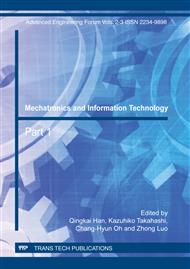p.123
p.127
p.131
p.135
p.140
p.144
p.148
p.153
p.156
Simulation Analysis on Cymbal Transducer
Abstract:
The resonance frequency of the cymbal transducer ranges from 2kHz to 40kHz and its effective electromechanical coupling factor is around 20%. Finite element analysis has been performed to ascertain how the transducer’s makeup affect the transducer’s performance parameters. Two-dimensional axisymmetric model of the cymbal transducer was founded by finite element software-ANSYS, the application of the element type was discussed and the FEM models were built up under the far field condition. Eight groups of cymbal transducers of resonance frequency around 3kHz with different structural dimensions were designed. It was better for choosing the cymbal transducer of the 8mm cavity coping diameter, 20.8mm cavity bottom diameter and 26.8mm piezoelectric ceramic wafer diameter than others for reducing distortion degree of the signal and improving communication turnover in the researched cymbal transducers. It was appropriate for choosing the cymbal transducer of the 8mm cavity coping diameter, 22.4mm cavity bottom diameter and 26.4mm piezoelectric ceramic wafer diameter in order to improve the free-field voltage sensitivity and transmission efficient.
Info:
Periodical:
Pages:
140-143
Citation:
Online since:
December 2011
Authors:
Permissions:
Share:
Citation:


